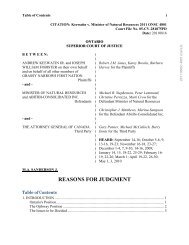COURT OF APPEAL FOR ONTARIO
COURT OF APPEAL FOR ONTARIO
COURT OF APPEAL FOR ONTARIO
Create successful ePaper yourself
Turn your PDF publications into a flip-book with our unique Google optimized e-Paper software.
Page: 56<br />
(3) The motion judge erred in his application of the rule in<br />
Browne v. Dunn and thus deprived Hryniak of the<br />
opportunity to respond to the allegations against him. 9<br />
[120] We say at the outset that we see no merit in the third ground of appeal. Hryniak<br />
knew the case against him and was aware of the allegations against him made by both the<br />
Mauldin group and Bruno. He had ample opportunity to respond to those allegations, and<br />
indeed endeavoured to do so both in his lengthy affidavits and in cross-examinations on<br />
those affidavits. The balance of these reasons, therefore, will only address the first two<br />
grounds of appeal.<br />
2. Facts<br />
(1) The Mauldin Group Action<br />
(i)<br />
The investment<br />
[121] The critical meeting that led to the Mauldin group‟s investment occurred on June<br />
19, 2001. Mauldin, Hryniak, Peebles and Cranston attended. 10 No party has<br />
contemporaneous notes of what was said at the meeting, and recollections vary. All<br />
parties agree, however, that during the meeting Hryniak explained that he had an<br />
investment company called Tropos Capital and that he wanted to raise at least U.S.$10<br />
million to invest through a joint venture called the Tropos Joint Venture.<br />
9 The rule in Browne v. Dunn requires a party to give notice to a witness whose evidence he intends to impeach.<br />
10 As noted earlier, Cranston was not sued in either action. Also, he did not give evidence on the motions.
















